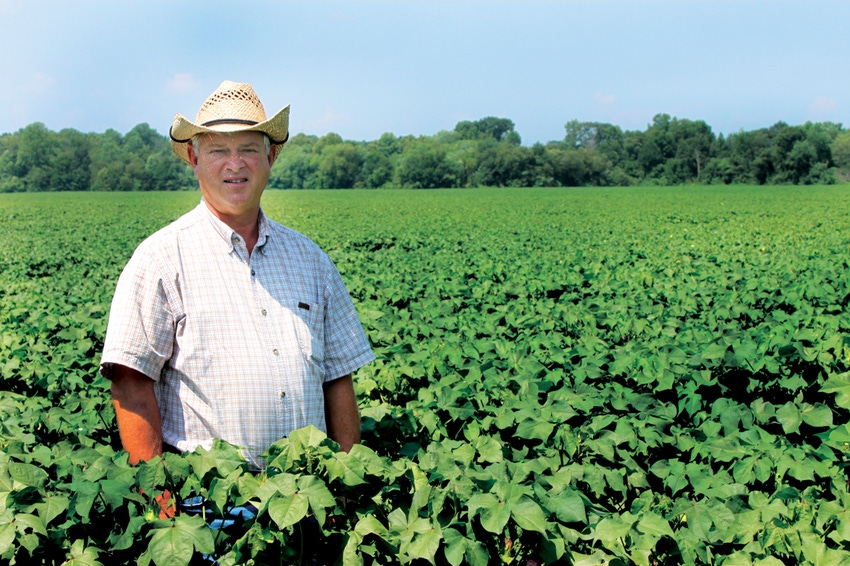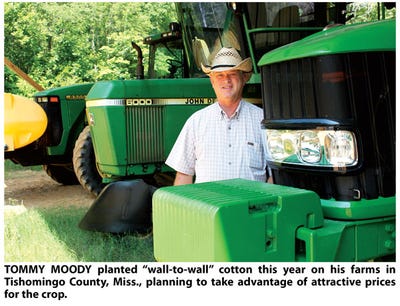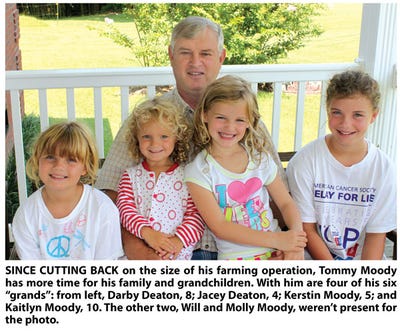
In most years, on a few of the fields he farms here in the northeast corner of Mississippi, just a hop, skip, and jump from the Alabama state line, Tommy Moody will plant corn for the rotation benefit it brings to cotton the following year.
Not this time: “It’s wall-to-wall cotton,” he says. “Farming dryland, and with prices as they are, the returns potential for cotton was better than for corn.”
He has already price-fixed about 35 percent of his cotton through his gin on mill-direct contracts ranging from $1.02 to $1.42, and hopes $1-plus prices will still be available for the rest of the crop at harvest time.
Moody, who grew up here in the small town of Belmont, in Tishomingo County, didn’t come from a farming family, and didn’t start out to be a farmer.
“After I finished high school, I went to Northeast Mississippi Community College,” he says. “The Vietnam War was going on and I was in the National Guard and doing carpentry work. My uncle, who was a full-time farmer, asked me to help him and I discovered that farming was something I really liked — being independent and seeing the results of your work growing in the fields and in the harvest at the end of the season. In 1978, I bought him out, and I’ve been farming on my own ever since.”
In the 1950s and early 1960s, his uncle had grown cotton, but in the late ‘60s got out because insects — bollworms/budworms and boll weevils — were making it almost impossible to grow a decent crop. So, his uncle switched to soybeans instead.
“When I started farming on my own, I grew soybeans and some corn for 10 or 12 years,” Moody says. “In 1991, I started easing back into cotton — only 100 acres — and kept gradually increasing until, by 1998, I was all cotton.
“I rotate corn on a few of the bottomland fields that are suitable, but year-in, year-out the bulk of the acreage is cotton. This year, with prices the way they’ve been, I’m wall-to-wall cotton.”
Today, Moody is one of only three cotton growers in the county, and has something over a third of the total acreage.
To the west, most of the land is hills, covered in trees; to the east, across the Alabama line, more woods. But, centered around Belmont, in creek valleys, is the silt loam land that Moody and other growers farm.
Farms 40 fields
“All the land is non-irrigated,” he says. “Altogether, I have probably 40 fields; the largest is about 92 acres, and from there they range all the way down to a few acres. But, a lot of the fields are contiguous along Hwy. 366, all the way to the Alabama line, about six miles. I don’t have to do a lot of equipment movement.”
Most of Moody’s acreage this year is planted to Phytogen 375 WRF, a WideStrike, Genuity, Roundup Ready, Flex variety.
 “I’ve planted this cotton for the past three to five years,” he says, “and have been very pleased with it, both from a yield and grade standpoint. My rep, Joe Camp at Mantachie, Miss., also got a few bags of their 499 WRF for me to try; it’s doing really well so far, and I’m looking forward to seeing how it turns out. I’ve also got some Deltapine 0912 B2RF.”
“I’ve planted this cotton for the past three to five years,” he says, “and have been very pleased with it, both from a yield and grade standpoint. My rep, Joe Camp at Mantachie, Miss., also got a few bags of their 499 WRF for me to try; it’s doing really well so far, and I’m looking forward to seeing how it turns out. I’ve also got some Deltapine 0912 B2RF.”
Last year, his average across all fields was 820 pounds and, he says, “I’m hoping to do as well or better this year, if we can get some timely rains. We’ve been fortunate to this point to get enough rain to keep plants from doing much shedding.
“On my best farm, good bottomland, I have a 920 pound average; on the upland fields, yields will run 650 pounds to 750 pounds.
“I’ve been all no-till since 1995 for cotton. The only time I’ll go in and level fields is if they were rutted up during fall harvesting. Over the years, I’ve kept terraces up, and since I’ve gone to no-till, there’s almost no erosion on any of the land.”
He tries to burn down in March with Roundup and Clarity, then puts down Cotoran behind the planter. Depending on the year and situation, he uses Diuron or Diurex as a full-season direct spray.
“With these Flex varieties, I just spray Roundup for any cleanup that’s needed,” Moody says. “Thus far, we haven’t had much of a problem with resistant weeds — some marestail — but the way resistant pigweed is spreading elsewhere, we probably will have some showing up sooner or later.
“The soils here tend to be a bit on the cool side in the spring, so I’ll usually try and plant in the April 25-May 15 window. I was about six to eight days late this year due to all the early rains, but with all the hot days we’ve had I think the cotton has pretty much made up that time. It’s at four to five nodes above white flower right now (July 27).”
He pulls soil samples almost every year and applies organic fertilizer (chicken litter). Based on soil sample results, potash and phosphate are added as needed.
“I’ve made three applications of Pix so far this season,” Moody says, “and I’m hoping that will hold things until harvest. In some spots, I’ve applied as much as 40 oz., but the average is about 20 oz. Although the specialists say there is no yield benefit from Pix, I’ve always felt I picked better cotton if the plants weren’t rank.
“I’ll use Finish or Def/Folex as a defoliant, generally depending on which has the best price, and etephon as a boll opener.”
Relies on consultant's experience
Moody’s consultant, Homer Wilson, Fulton, Miss., has done all his scouting for several years.
“He’s 78 years old, but still works like a Trojan,” Moody laughs. “He has forgotten more than I’ll ever know about insects and spraying. He gets out there and walks the fields, and his years of experience tells him what’s going on. “When he tells me to spray — or not to spray — I know I can follow his advice with confidence that it’ll save money for me or make money for me.
“Plant bugs are usually our biggest insect problem. I’ve sprayed for them three times thus far this season.”
It was a different story, though, when he got back into cotton in 1991.
“I could go into a field and pull 25 squares and almost be at the threshold to spray for boll weevils. The boll weevil eradication program has been a tremendous benefit to cotton growers. We went through some tough times with other pests in the early years of the program, but now we don’t have to worry about weevils any more — the results are well worth the investment growers have made.
“In 1995, we were spraying hot and heavy for budworms, and were averaging only 400 pounds per acre, with insecticide costs of $150 or more. Then, Bt cotton came along and it has been a real game changer. This technology has made a major difference in the way everyone in the Southeast grows cotton.”
He usually starts harvesting the last week in September and can usually finish in 20 days of actual picking with his four-row John Deere 9965 picker.
Moody’s cotton is ginned at Servico Gin, Courtland, Ala., “They’re 62 miles away, but they come and pick up my cotton and gin it. Before the big drop in cotton acres, they were ginning 50,000 to 60,000 bales per year, but I think they were down to about 30,000 last year.
“I didn’t manage to sell any cotton for $1 last year, but this year I’ve fixed about 35 percent of my expected yield at $1.02 and $1.42. In addition to the mill direct contracts through the gin, I also sell through Staplcotn.”
At one time, Moody says, he was farming twice the acreage he has now.
“But, a lot of the time it seemed I was chasing myself, trying to get everything done. I felt like I was wasting a lot of time, just moving equipment about and changing out equipment for different operations. Once I got my last child out of college, I started cutting back, and now I plan to stay pretty much at the level I am now so I can handle everything myself and have time for my family and my grandchildren.
“I do pretty much all of my equipment maintenance; I don’t buy a piece of equipment until I have to. I have an old Ford 8700 tractor that’s still running. I’ve always bought good used equipment, but last year I bought my first new tractor, a John Deere 7330.”
His nephew, Jimmy Moody, and great-nephew, Kaleb Moody, help out at busy times, and he occasionally hires some outside labor.
Most of Moody's land is rented — "I only own about 113 acres,” he says.
His long-time carpentry skills were put to good use when he built his new house about eight years ago, and he is now in the process of completing work on a new shop/equipment storage building.
“Because of time constraints, I had to contract some of the house work,” he smiles, “but I’m still pretty handy with carpentry tools.”
Moody is active in the Mississippi Farm Bureau Federation and is on the Mississippi State University Extension Advisory Committee. He and his wife, Joan, who retired after 25 years as a fifth/sixth grade teacher, are members of the Liberty Church of Christ.
Their children and in-laws are Kerry Moody, football coach at Belmont, and his wife, Kerri, hospital administrator at Russellville, Ala.; Kendra Moody Deaton, first grade teacher, and her husband, Andy Deaton, baseball coach, at Belmont; and Kale Moody, engineer with Taylor Machine Works, Louisville, Miss., and wife, Samantha, a nurse. Tommy and Joan have six grandchildren, five girls and a boy.
About the Author(s)
You May Also Like




